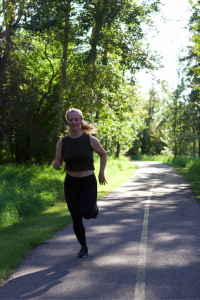Amanda Regnier, MSc., C.S.C.S
Running optimization specialist
Running with Regnier
So you started running and your knees started to hurt. Why does this HAPPEN???
It must be running that did it, right? Since so many people who run also have achy knees, they must be related – “running causes achy knees” – could this be true? Take this concept into a different context. Can you build a fire using only oxygen? No. The right combination of oxygen + heat + fuel will create a fire, but just having oxygen alone will do nothing. However, adding oxygen to an already burning fire will certainly make it grow. A similar concept can be applied to your knees. If your knees are strong and healthy, running should not cause any pain. However, if you have pre-existing structural damage/ weaknesses, additional impact forces (like running) can certainly cause pain. To say running alone causes knee pain is equivalent to saying you can start a fire using only oxygen.
If your knees are strong and healthy, running should not cause any pain
How do you know if your knees can handle the impact of running?
There is a simple question you can ask yourself – have you done ANYTHING to improve the strength of your knees since puberty? Your muscles, tendons and bones (yes BONES) are extremely active tissues. Generally what this means is that your body is in a constant state of either getting stronger or getting weaker – there is no maintenance. In fact your bones (including your knees) will be the strongest they will ever be up until around puberty. After this point, your bone density will slowly decrease over the rest of your life. On the up side, you can personally affect the rate bone density is lost. This will be dependent on your level of activity….no activity and “hello early osteoporosis”. Conversely, with the right amount and type of activity you can significantly decrease the rate at which your bones breakdown. You can read more about my strength training services here.
you can personally affect the rate of bone density loss
Now, back to the initial question…
How do you know if your knees can handle the impact of running? If you have been strength training regularly – including a combination of posterior chain exercises (glutes/ hams), unilateral work, and plyometrics (to name a few) – you are in a significantly better position to run with a lower likelihood of knee pain. Note here that genetics, and of course injury history, will influence knee health as well. Some examples of posterior chain exercises are Nordic Leans or Romanian Dead Lifts. Unilateral work includes single leg exercises such as Step-Ups and Split Squats and plyometrics just means jumping-like exercises such as a vertical jump or box jump.
If you have done mostly low/ no impact activities before taking up running, your knees are less likely to be able to handle the impact of running. This does not mean you should not run, it just means that your running training program should increase very slowly increase in length/ intensity. And it should absolutely be accompanied by a strength program.
Personally, I love the work Ben Patrick has been doing, in terms of building bullet-proof knees with his athletes and he links some great exercises videos in his Athletic Truth Group instagram. For a deeper dive into the philosophy of building healthy knees for life, Just Fly Performance Podcast (#148) interviews Ben Patrick on how he trains his athletes and some safer exercises beginners can try at home. (Spoiler alert: these include activities such as pulling sleds and walking backwards up a treadmill!). In addition, including other aerobically based cross training activities such as swimming could be a great way to supplement your running training to help improve fitness! Drop into the Thursday LYNX run sessions I coach if you would like to meet. To learn more about all LYNX group training options check out this classes page or contact us at coaches@lynxtriathlon.ca.
